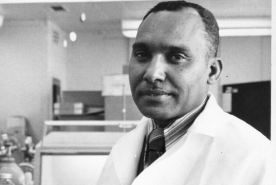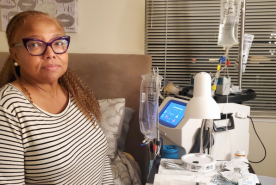March 26, 2024
By Lauren Drew, Congressional Relations Director
Many patients are not informed when they first begin dialysis that there are more options beyond the traditional in-center, in-a-chair, 3 times a week system. Only 14% of patients on dialysis in the US are using at-home options, despite evidence showing that it may be a better option for some patients1.
The Improving Access to Home Dialysis Act (H.R. 8075) was introduced in the US House of Representatives in April 2024 by Reps. Carol Miller (R-WV), Marilyn Strickland (D-WA), Mariannette Miller-Meeks (R-IA), and Earl Blumenauer (D-OR) with the hope of expanding access to this life-saving treatment. Ask your Representative to support this important legislation!
What is home dialysis?
Home dialysis is a form of renal (kidney) replacement therapy (aka, dialysis) that can be done at home by the patient alone or with the help of a care partner. The two main options for home dialysis are peritoneal dialysis (PD) and home hemodialysis (HHD).
Peritoneal dialysis uses the inside lining of the patient’s abdomen, which acts as a natural filter. Unlike hemodialysis, no blood leaves the body. A catheter is placed in the patient’s belly, and a cleansing fluid called dialysate is washed in and out of the belly in cycles to filter the blood and wash out extra fluids and waste. A patient can do this one of two ways:
- Continuous Ambulatory Peritoneal Dialysis (CAPD): With CAPD, a patient does the exchanges themselves, three to four times a day. There are no machines. The patient put a bag of dialysate (about two quarts) into the peritoneal cavity through a catheter in the abdomen. The dialysate stays there for about four or five hours before it is drained back into the bag and thrown away.
- Automated Peritoneal Dialysis (APD): ADP is usually done at home using a special machine called a cycler, which delivers and then drains the cleansing fluid. Treatments are usually done at night while the patient sleeps.
Home hemodialysis is a similar process to in-center hemodialysis, but the treatments are done at home. Patients connect to a dialysis machine, similar to the one in the facility but more portable, which draws out and filters their blood to remove waste and excess fluid. HHD allows for more frequent, and longer but gentler, dialysis sessions than a patient would get in a facility. This leads to fewer side effects and better outcomes for patients.
Both PD and HHD offer patients convenience and flexibility. Instead of having a rigid dialysis schedule set for them, patients can do their treatments in the comfort of their own homes, at a time that works for them. They don’t have to spend hours traveling back and forth to their dialysis facility, which for some patients can be over an hour each way, and in many cases can take their home dialysis machines with them on work or vacation travel. This flexibility can greatly improve the quality of life for patients and their families. Patients are more likely to maintain employment, report improved quality of life, and are more likely to remain healthy enough to qualify for transplantation.
Addressing barriers
There are a couple of key issues that prevent more patients from accessing and succeeding on home dialysis. One is a lack of education and awareness. Many kidney patients are not told that home dialysis is a viable treatment option, and not all dialysis facilities are trained and certified to offer home dialysis. This is partly a result of patients getting a late diagnosis and crashing onto dialysis in an emergency setting. It does take a patient some time to prepare for home dialysis. There is specific training a patient must complete and preparations for their body such as catheter placement, that must be done before home dialysis can begin. If a patient is unaware that they are in kidney failure and they have a sudden, unplanned start on dialysis, it will almost always be in a facility.
Home dialysis can also require a strong support system to ensure that patients can safely and effectively dialyze at home. Not all patients are comfortable managing their treatment alone, and some may not have a family or friend care partner. Without adequate support, patients may feel overwhelmed and be discouraged from pursuing home dialysis.
Finally, for patients who have been informed of their options and indicate that they are interested in home dialysis, the wait to get trained to do it properly can be too long. There is a nursing shortage and current regulations limit which healthcare providers can train patients for home dialysis and where it can happen. This can cause long waits for patients, sometimes up to a year. We know that the longer a patient waits to get trained, the less likely they are to complete the training and move to a home modality.
What can we do to address these barriers to home dialysis?
NKF has been working on a piece of legislation that will address these three issues. The Improving Access to Home Dialysis Act will:
- Mandate that patients get proper education on all of their dialysis options, including making sure that even patients who crash onto dialysis with no preparation can get education on other options once they have stabilized and can make informed decisions about their future.
- Expand the universe of healthcare providers who can provide home dialysis training to remove the burden from the nursing staff and cut down on wait times to get trained. It would also allow for the use of group training, telehealth, and off-site training when appropriate.
- Cover the costs of in-home healthcare support staff for patients when they’re beginning their home dialysis journey. This in-home assistance would help patients transition from the facility and support the patient and if available, their care partner, with the goal that they become fully independent over time. Some patients with certain disabilities or other concerns could be eligible for continuing in-home assistance.
We hope that these changes will help more patients succeed on home dialysis and that in turn, they will have better outcomes and improved quality of life. We acknowledge that home dialysis is not right for all patients, but it is important that all patients receive the information and support they need to choose the treatment that best fits their lives and goals. Please reach out to your Members of Congress and ask them to support The Improving Access to Home Dialysis Act.
Source
1 United States Renal Data System. 2023 USRDS Annual Data Report: Epidemiology of kidney disease in the United States. National Institutes of Health, National Institute of Diabetes and Digestive and Kidney Diseases, Bethesda, MD, 2023.









